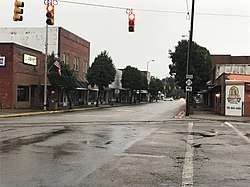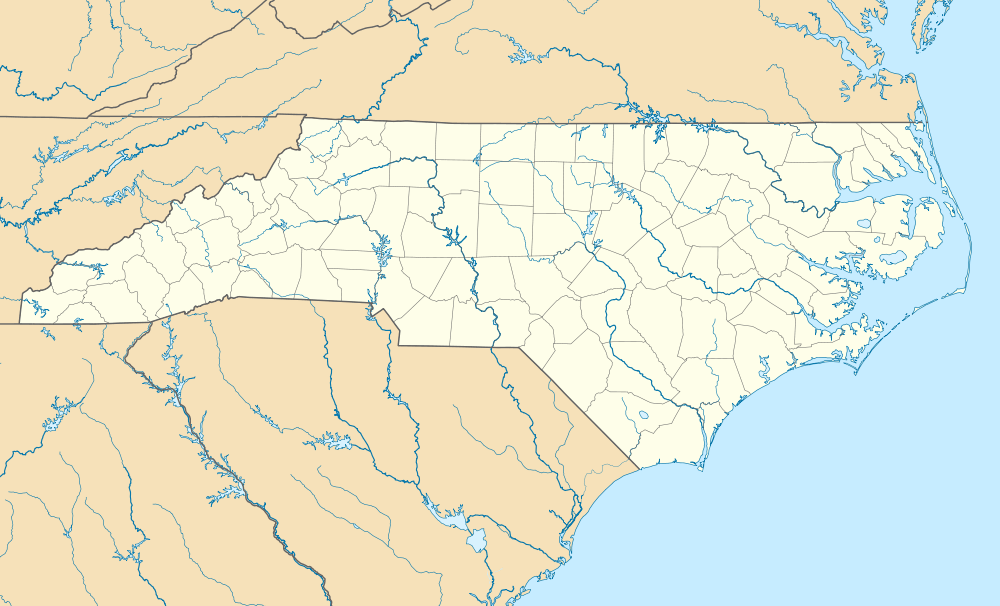Red Springs, North Carolina
Red Springs is a town in Robeson County in the U.S. state of North Carolina. The population was 3,428 at the 2010 census.[5]
Red Springs | |
|---|---|
 Main Street | |
 Red Springs Panto  Red Springs Panto | |
| Coordinates: 34°48′52″N 79°11′3″W | |
| Country | United States |
| State | North Carolina |
| Counties | Robeson |
| Government | |
| • Mayor | Ed Henderson |
| Area | |
| • Total | 3.67 sq mi (9.50 km2) |
| • Land | 3.50 sq mi (9.07 km2) |
| • Water | 0.17 sq mi (0.44 km2) |
| Elevation | 207 ft (63 m) |
| Population (2010) | |
| • Total | 3,428 |
| • Estimate (2019)[2] | 3,302 |
| • Density | 943.43/sq mi (364.21/km2) |
| Time zone | UTC-5 (Eastern (EST)) |
| • Summer (DST) | UTC-4 (EDT) |
| ZIP code | 28377 |
| Area code(s) | 910 Exchanges:359,843 |
| FIPS code | 37-55660[3] |
| GNIS feature ID | 1022199[4] |
| Website | www |
Geography
Red Springs is located in northern Robeson County at 34°48′52″N 79°11′3″W (34.814363, -79.184281).[6] North Carolina Highways 211 and 71 are the main roads through the town, joining to form North Main Street. NC-211 leads north 12 miles (19 km) to Raeford and southeast 18 miles (29 km) to Lumberton, while NC-71 leads northeast 8 miles (13 km) to Lumber Bridge and southwest 12 miles (19 km) to Maxton. North Carolina Highway 72 leaves Red Springs on South Main Street, leading south via Philadelphus 19 miles (31 km) to Lumberton.
According to the United States Census Bureau, the town of Red Springs has a total area of 3.7 square miles (9.5 km2), of which 3.5 square miles (9.1 km2) are land and 0.2 square miles (0.4 km2), or 4.61%, are water bodies.[5]
History
Long before Red Springs was incorporated in 1887 and its postal name changed from its former name of Dora in 1884, one of the first settlers in this community was "Sailor Hector" McNeill. It is not known exactly how he got his nickname, but he is found using it in the Bladen County tax lists of 1771.[7] (Red Springs is in Robeson County which was formed from Bladen County in 1787.) "Sailor Hector" McNeill's home was at the top of the hill on the edge of the McNeill cemetery in town, and he and his wife Mary are buried there in unmarked graves.[8]
In the decades before the Civil War up into the early 20th century the community was known as "The Springs", and it became a popular spa and resort in the mid-19th century. People of that time came from all parts to sample the sweet, iron-rich water and stay at the hotel there, built before 1854 by Malcolm C. McNeill, the grandson of "Sailor Hector". A letter from a native of the area living in Mississippi dated 1854 mentions that "Red Springs" had a store.[9] From that time and far beyond its incorporation in 1887, Red Springs grew a great deal.
Between 1896 and 1915, Red Springs had a military school for boys as well as the Southern Conservatory of Music for girls from all over the country. The military school is long gone, but in time the conservatory became Flora McDonald College, known today as Flora McDonald Academy, a private day school. In the 1840s, Floral College for young women was established a few miles south of town by a local lawyer, John Gilchrist, Jr. of Mill Prong House. The school operated until the Civil War, reopened afterward, but closed its doors around 1870.
From 1947-1950, Red Springs fielded a professional minor league baseball team, the Red Robins, that was a farm team of the Philadelphia Athletics. The team won the Tobacco State League championship in 1948. In 1949, led by pitcher Bill Harrington, who would go on to pitch for the big league parent club, the Red Robins won a second title. The 1950 team was led by player/manager Ducky Detweiler, who had played for the Boston Braves.[10]
Professional baseball returned to Red Springs in 1969 when the Minnesota Twins organization moved its Class A franchise from Wilson, N.C. During the year the club drew more than 40,000 fans and were managed by Tom Umphlett, a former major leaguer and North Carolina native. Six future major Leaguers were on the Red Springs roster. The team lasted only one season
Demographics
| Historical population | |||
|---|---|---|---|
| Census | Pop. | %± | |
| 1900 | 858 | — | |
| 1910 | 1,089 | 26.9% | |
| 1920 | 1,018 | −6.5% | |
| 1930 | 1,300 | 27.7% | |
| 1940 | 1,559 | 19.9% | |
| 1950 | 2,245 | 44.0% | |
| 1960 | 2,767 | 23.3% | |
| 1970 | 3,383 | 22.3% | |
| 1980 | 3,607 | 6.6% | |
| 1990 | 3,799 | 5.3% | |
| 2000 | 3,493 | −8.1% | |
| 2010 | 3,428 | −1.9% | |
| Est. 2019 | 3,302 | [2] | −3.7% |
| U.S. Decennial Census[11] | |||
As of the census[3] of 2000, there were 3,493 people, 1,320 households, and 893 families residing in the town. The population density was 1,233.0 people per square mile (476.6/km2). There were 1,458 housing units at an average density of 514.7 per square mile (198.9/km2). The racial makeup of the town was 49.16% African American, 38.19% White, 8.65% Native American, 0.34% Asian, 0.14% Pacific Islander, 2.32% from other races, and 1.20% from two or more races. Hispanic or Latino of any race were 3.66% of the population.
There were 1,320 households, out of which 28.0% had children under the age of 18 living with them, 38.5% were married couples living together, 23.6% had a female householder with no husband present, and 32.3% were non-families. 28.7% of all households were made up of individuals, and 15.2% had someone living alone who was 65 years of age or older. The average household size was 2.56 and the average family size was 3.10.
In the town, the population was spread out, with 26.0% under the age of 18, 9.0% from 18 to 24, 23.8% from 25 to 44, 22.8% from 45 to 64, and 18.3% who were 65 years of age or older. The median age was 38 years. For every 100 females, there were 82.1 males. For every 100 females age 18 and over, there were 81.8 males.
The median income for a household in the town was $24,194, and the median income for a family was $34,760. Males had a median income of $25,655 versus $18,974 for females. The per capita income for the town was $15,347. About 26.0% of families and 30.4% of the population were below the poverty line, including 50.6% of those under age 18 and 14.7% of those age 65 or over.
References
- "2019 U.S. Gazetteer Files". United States Census Bureau. Retrieved July 27, 2020.
- "Population and Housing Unit Estimates". United States Census Bureau. May 24, 2020. Retrieved May 27, 2020.
- "U.S. Census website". United States Census Bureau. Retrieved 2008-01-31.
- "US Board on Geographic Names". United States Geological Survey. 2007-10-25. Retrieved 2008-01-31.
- "Geographic Identifiers: 2010 Census Summary File 1 (G001): Red Springs town, North Carolina". American Factfinder. U.S. Census Bureau. Archived from the original on February 13, 2020. Retrieved December 21, 2017.
- "US Gazetteer files: 2010, 2000, and 1990". United States Census Bureau. 2011-02-12. Retrieved 2011-04-23.
- Bladen County, North Carolina Tax Lists 1768 - 1774 Volume 1, page 59, by William Byrd III
- A History of Red Springs by Mrs. George Bullock, 1969.
- "Capefearclans MiscRecs_ Letters, etc". capefearclans.com. Retrieved Jul 27, 2019.
- Holaday, Chris (2016). "The Tobacco State League; A North Carolina Baseball History, 1946–1950".. Jefferson, N.C.: McFarland. ISBN 978-1-4766-6670-9.
- "Census of Population and Housing". Census.gov. Retrieved June 4, 2015.